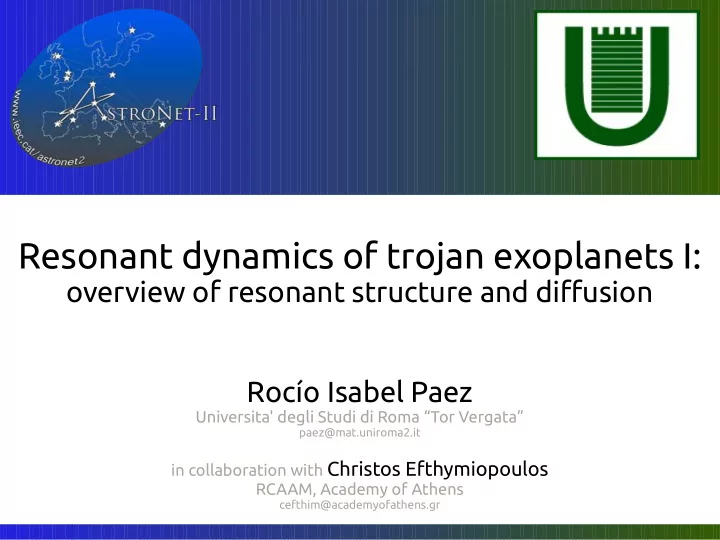

Resonant dynamics of trojan exoplanets I: overview of resonant structure and diffusion Rocío Isabel Paez Universita' degli Studi di Roma “Tor Vergata” paez@mat.uniroma2.it in collaboration with Christos Efthymiopoulos RCAAM, Academy of Athens cefthim@academyofathens.gr
Contents Introduction motivation Formulation hierarchical construction of the hamiltonian computation of resonant proper elements 2 Numerical experiments production of phase portraits and stability maps parametric study of μ and e' identification of the corresponding web of resonances numerical computation and characterization of chaotic diffusion Conclusions 2
Introduction Motivation 3
Introduction Motivation 4 t e n a l p n a j o r t
Construction of the hamiltonian Starting point: pERTBP and further generalizations Modified Delaunay variables 5 Complete Hamiltonian 5
Construction of the hamiltonian Forced equilibrium 6 Forced equilibrium position
Construction of the hamiltonian Expansion around the forced equilibrium o where 7
Construction of the hamiltonian Considerations about 8 8
Construction of the hamiltonian Classification of resonances secondary 9 resonances 1:n transverse secular 9
Construction of the hamiltonian Planar ERTBP then 10 shift with respect to L 4 with 10
Numerical Experiments
Parametric Study Phase portraits for e' = 0 (CRTBP) pericenter crossing condition 0.001 ≤ μ ≤ 0.01 Δμ = 0.001 35 initial conditions along the 0.0 ≤ Δu ≤ 1.0 Δ(Δu) ~ 0.03 line x = B(u-u 0 ) μ = 0.0041 a) e p = 0.0001 b) e p = 0.06 12 c) e p = 0.1 μ = 0.0031 d) e p = 0.0001 e) e p = 0.05 f) e p = 0.1 12
Parametric Study FLI stability maps 400x400 e p 0 ≤ Δu ≤ 1 0 ≤ e p ≤ 0.1 Δt = 1/300 T ~ 1000 periods 13 Δu e' = 0 e' = 0.02 e' = 0.6 13
Parametric Study Survey of resonances μ = 0.0041 (1:6) A) e' = 0, B) e' = 0.02, C) e' = 0.04, D) e' = 0.06, E) e' = 0.08, F) e' = 0.1 14 14
Parametric Study Survey of resonances - Another example μ = 0.0012 (1:12), 0.0014 (1:11), 0.0016 (1:10), 0.0021 (1:9), 0.0024 (1:8), 0.0031 (1:7), 0.0041 (1:6) and 0.0056 (1:5) A) e' = 0, B) e' = 0.02, C) e' = 0.04, D) e' = 0.06, E) e' = 0.08, F) e' = 0.1 15 15
Parametric Study Dependence on μ 400x400 ep = e' = 0.02 16 Resonances 16
Chaotic Diffusion Kinds of diffusion Parameters e' = 0.02 μ = 0.0041 e p = 0.01625 17 Initial Conditions x = 0 φ = π/3 Y f = 0 Δu = 0.299 Δu = 0.376 Integration 10 periods 17
Chaotic Diffusion Main paradigm of diffusion: modulational e' = 0 e' = 0 e' = 0.02 μ = 0.0041 e p = 0.01675 Δu = 0.376 18 e p,0 e p,0 e p e p 18
Statistics of Orbits Classification of orbits regular orbits escaping orbits > 19 transition orbits Snapshots at T = 10,10,10,10,10 periods 19
Statistics of Orbits Stastistical results 20 (a) T = 10, (b) T = 10, (c) T = 10, (d) T = 10, (e) T = 10
Statistics of Orbits Stastistical results Power law α ~ 0.8 21
Statistics of Orbits Comparision between FLI and escaping times Transition orbits T esc < 10 regular orbits Tesc > 10 Escaping orbits
Conclusions Hamiltonian Formalism in modified Delaunay variables secular effects, due to one or more planets hierarchy of Hamiltonian models corresponding to different levels of perturbation resonant proper elements characterisation of resonances 23 Visualization of the resonant web - dependence on physical parameters phase portraits FLI maps Chaotic diffusion & statistics of escapes different paradigms and rates of chaotic diffusion statistical study of an ensemble of orbits in the resonant domain two characteristic peaks in the escaping times distribution correlation between the escaping times and the structure of the resonant web 23
Thanks for your attention! Questions?
Secular dynamics adding more planets frequencies of the leading terms in the quasi-periodic representation of the oscillations of the planets' eccentricity vectors with and the amplitudes of oscillation of the ecc. vector and trigonometric on
Correlation between the proper libration and Δu Action labels libration motion around the forced eq. point We define Δu in the following way: for given e p , we compute the position of the fixed point. We then consider all the invariant curves around the eq. point (x = 0,u = u 0 ) of the 1 d.o.f. We also take the line x = B(u-u 0 ). We call up the point where the invariant curve intersects the line. We finally define Δu = (u p -u 0 ). Up to quadratic terms in Δu, one has In general, for B ≠ 0, Δu ≠ D p (half-width of the oscillation of the variable u along the invariant curve of corresponding to the action variable J s ), which is the common definition of the proper libration. Instead, one has
Recommend
More recommend